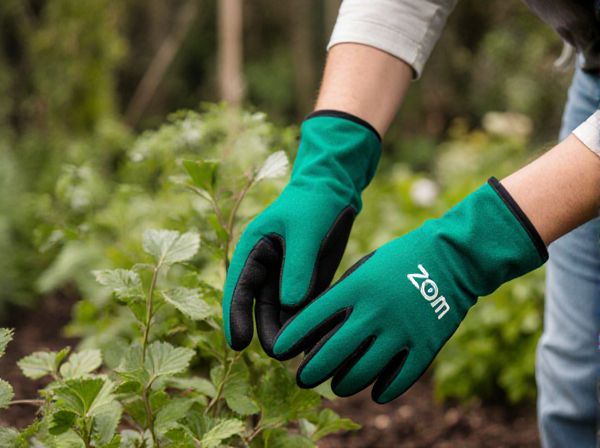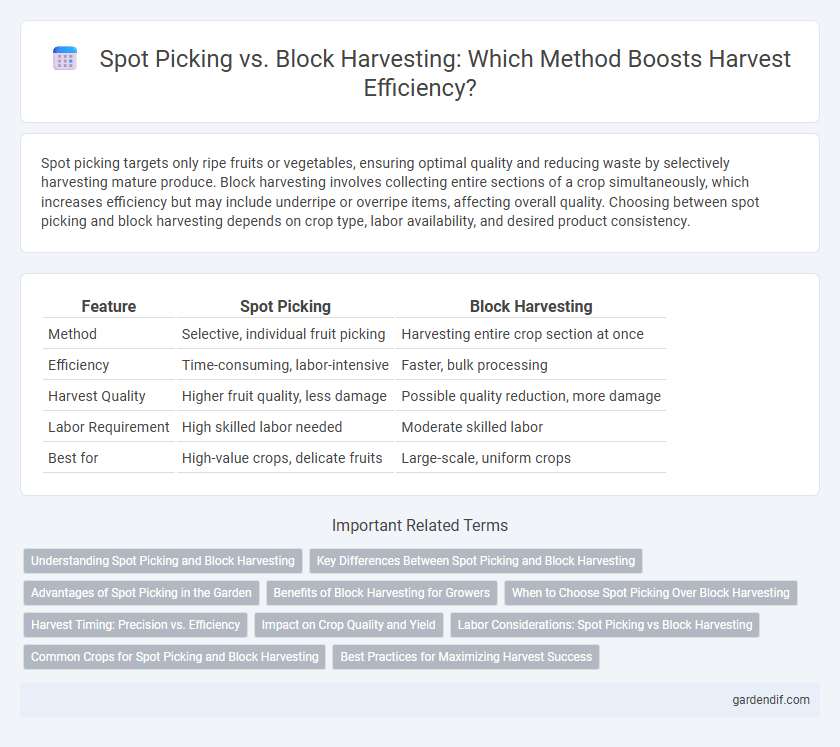
Spot Picking vs Block Harvesting Illustration
Spot picking targets only ripe fruits or vegetables, ensuring optimal quality and reducing waste by selectively harvesting mature produce. Block harvesting involves collecting entire sections of a crop simultaneously, which increases efficiency but may include underripe or overripe items, affecting overall quality. Choosing between spot picking and block harvesting depends on crop type, labor availability, and desired product consistency.
Table of Comparison
| Feature | Spot Picking | Block Harvesting |
|---|---|---|
| Method | Selective, individual fruit picking | Harvesting entire crop section at once |
| Efficiency | Time-consuming, labor-intensive | Faster, bulk processing |
| Harvest Quality | Higher fruit quality, less damage | Possible quality reduction, more damage |
| Labor Requirement | High skilled labor needed | Moderate skilled labor |
| Best for | High-value crops, delicate fruits | Large-scale, uniform crops |
Understanding Spot Picking and Block Harvesting
Spot picking involves selectively harvesting individual fruits or vegetables at peak ripeness, maximizing quality and minimizing waste. Block harvesting entails gathering entire sections of crops simultaneously, optimizing efficiency and reducing labor costs. Understanding the benefits and applications of each method helps farmers balance crop quality and operational productivity.
Key Differences Between Spot Picking and Block Harvesting
Spot picking targets selective fruit or crop harvesting in specific areas, optimizing quality and reducing damage by allowing careful handpicking of ripe produce. Block harvesting involves gathering all crops within a designated block simultaneously, maximizing efficiency and speed, particularly in mechanized operations. The key differences lie in precision and scale: spot picking emphasizes selective yield with higher labor intensity, while block harvesting focuses on bulk collection with faster throughput.
Advantages of Spot Picking in the Garden
Spot picking in the garden enhances precision harvesting by targeting only ripe fruits or vegetables, reducing waste and improving overall crop quality. This method supports extended harvest periods since plants are left undisturbed until produce is ready, promoting continuous growth and yield. Spot picking also minimizes damage to plants and surrounding produce, preserving plant health and ensuring sustained productivity.
Benefits of Block Harvesting for Growers
Block harvesting streamlines operations by enabling growers to efficiently collect large quantities of crops in a single pass, significantly reducing labor costs and time. This method helps maintain consistent crop quality through uniform harvesting conditions and minimizes crop damage by reducing handling. Growers also benefit from improved logistics and easier crop segregation, which enhances storage and transport efficiency.
When to Choose Spot Picking Over Block Harvesting
Spot picking is ideal when dealing with crops that are unevenly ripened or when quality control is essential for premium produce, such as vineyards or specialty fruits. This method reduces waste by targeting only the ripe produce, enhancing product quality and prolonging shelf life. It is best chosen for high-value crops where precise timing and careful handling maximize market value.
Harvest Timing: Precision vs. Efficiency
Spot picking allows precise harvest timing for individual plants or fruits, optimizing quality and reducing waste by targeting peak ripeness. Block harvesting prioritizes efficiency, quickly collecting large quantities by harvesting entire sections simultaneously, which can lead to varying fruit maturity levels within the batch. Choosing between spot picking and block harvesting depends on the crop type and market demands for quality versus volume.
Impact on Crop Quality and Yield
Spot picking targets only ripe fruits, reducing damage to crops and enhancing overall quality by minimizing contact with unripe produce, which results in higher market value. Block harvesting collects large sections of crops simultaneously, increasing yield efficiency but potentially lowering fruit quality due to the inclusion of unripe or overripe produce. Balancing spot picking and block harvesting techniques maximizes both crop quality and total yield, optimizing profitability for farmers.
Labor Considerations: Spot Picking vs Block Harvesting
Spot picking optimizes labor efficiency by targeting only ripe produce, reducing unnecessary handling and minimizing worker fatigue during harvest. Block harvesting requires more intensive labor during a confined period, demanding larger, but shorter, labor forces for simultaneous crop collection. Both strategies impact labor scheduling and costs differently, influencing overall harvest productivity and workforce management.
Common Crops for Spot Picking and Block Harvesting
Spot picking is ideal for crops like strawberries, tomatoes, and blueberries, where selective harvesting ensures peak ripeness and quality. Block harvesting suits grains such as wheat, corn, and barley, enabling efficient collection of large, uniform fields. Both methods optimize yield and labor depending on the crop's growth pattern and market demand.
Best Practices for Maximizing Harvest Success
Spot picking targets ripe fruits individually, reducing waste and enhancing quality by ensuring only mature produce is harvested. Block harvesting efficiently collects large quantities at once but risks including unripe or overripe items, requiring careful timing and coordination. Implementing precise evaluation techniques and timely labor deployment optimizes yield and maintains product integrity across both methods.
Spot Picking vs Block Harvesting Infographic

 gardendif.com
gardendif.com